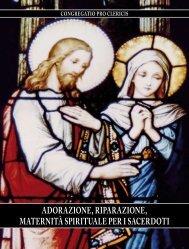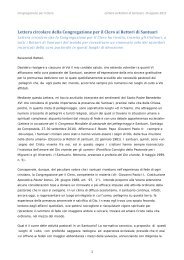La lingua nella liturgia di Rito Romano latino e lingua volgare
La lingua nella liturgia di Rito Romano: latino e lingua volgare
La lingua nella liturgia di Rito Romano: latino e lingua volgare
- No tags were found...
You also want an ePaper? Increase the reach of your titles
YUMPU automatically turns print PDFs into web optimized ePapers that Google loves.
As already quoted, article 36 of the Constitution on the Sacred Liturgy began by enacting that "particular law remaining in force,the use of the <strong>La</strong>tin language is to be preserved in the <strong>La</strong>tin rite". Article 54 required that steps be taken, "enabling the faithful tosay or sing together in <strong>La</strong>tin those parts of the Or<strong>di</strong>nary of the Mass belonging to them". In the celebration of the Liturgy of theHours, "in accordance with the centuries‐old tra<strong>di</strong>tion of the <strong>La</strong>tin rite, clerics are to retain the <strong>La</strong>tin language" (SC, n. 101).But even while establishing limits, the Council Fathers anticipated the possibility of a wider use of the vernacular. Article 54 indeedadds: "Wherever a more extended use of the mother tongue within the Mass appears desirable, the regulation laid down in Article40 of this Constitution is to be observed". Article 40 goes into <strong>di</strong>rectives on the role of Bishops' Conferences and of the ApostolicSee in such a delicate matter.The vernacular had been introduced. The rest is history. The developments were so fast that many clerics, Religious and lay faithfultoday are not aware that the Second Vatican Council <strong>di</strong>d not simply introduce the vernacular for all parts of the liturgy.Requests and widenings of the use of the vernacular were not long in coming. At the urgent request of some Bishops' Conferences,Pope Paul VI first allowed the Preface of the Mass to be said in the vernacular (cf. Letter of the Car<strong>di</strong>nal Secretary of State, 27 April1965), then the entire Canon and the prayers of or<strong>di</strong>nation in 1967.Finally, on 14 June 1971, the Congregation for Divine Worship sent notice that Episcopal Conferences could allow the use of thevernacular in all the texts of the Mass, and each Or<strong>di</strong>nary could give the same permission for the choral or private celebration ofthe Liturgy of the Hours (on the whole development, see A.G. Martimort: The Dialogue between God and his People, in A.G.Martimort: The Church at Prayer, I, p. 166).The reasons for the introduction of the mother tongue are not far to seek. It promotes better understan<strong>di</strong>ng of what the Church ispraying, since "Mother Church earnestly desires that all the faithful be led to that full, conscious and active participation in liturgicalcelebrations which is demanded by the very nature of the liturgy... (and which) is their right by reason of their Baptism" (SC, n. 14).At the same time, it is not <strong>di</strong>fficult to envisage how deman<strong>di</strong>ng and delicate the work of translation must be. Even more <strong>di</strong>fficult isthe question of adaptation and inculturation especially when we think of the sacredness of the sacramental rites, the centuries‐oldtra<strong>di</strong>tion of the <strong>La</strong>tin Rite, and the close link between faith and worship encapsuled in the old formula: lex oran<strong>di</strong>, lex creden<strong>di</strong>.We turn now to the thorny question of translations into the vernacular in the liturgy.7. On Translations into the VernacularThe translation of liturgical texts from the <strong>La</strong>tin original to the various vernaculars is a very important consideration in the prayerlife of the Church. It is a question, not of private prayer, but of the public prayer offered by holy Mother Church, with Christ as theHead. The <strong>La</strong>tin texts have been prepared with great care as to sound doctrine, exact wor<strong>di</strong>ng "free from all ideological influenceand otherwise endowed with those qualities by which the sacred mysteries of salvation and the indefectible faith of the Church areefficaciously transmitted by means of human language to prayer, and worthy worship is offered to God the Most High" (LiturgiamAuthenticam, n. 3).The words used in the sacred liturgy manifest the faith of the Church and are guided by it. The Church, therefore, needs great carein <strong>di</strong>recting, preparing and approving translations, so that not even one unsuitable word will be smuggled into the liturgy by anin<strong>di</strong>vidual who may have a personal agenda, or who may simply not be aware of the seriousness of the rites.Translations should, therefore, be faithful to the original <strong>La</strong>tin text. They should not be free compositions. As LiturgiamAuthenticam, the major Holy See Document that gives <strong>di</strong>rectives on translations, insists: "The translation of the liturgical texts ofthe Roman Liturgy is not so much a work of creative innovation as it is of rendering the original texts faithfully and accurately intothe vernacular language" (n. 20).The genius of the <strong>La</strong>tin Rite should be respected. The triple repetition is one of its characteristics. Examples are "mea culpa, meaculpa, mea maxima culpa"; "Kyrie eleison, Christe eleison, Kyrie eleison"; "Agnus Dei qui tollis...", three times. A close study of the"Gloria in Excelsis Deo" also shows "triplets". Translations should neither kill nor flatten out such a characteristic.The <strong>La</strong>tin liturgy expresses not only facts but also our feelings, our sentiments, for example, in front of God's transcendence,majesty, mercy and boundless love (cf. Liturgiam Authenticam, n. 25). Expressions like "Te igitur, clementissime Pater", "Suppliceste rogamus", "Propitius esto", "veneremur cernui", "Omnipotens et misericors Dominus", "nos servi tui", should not be deflatedand democratized by some translating iconoclast.Some of these <strong>La</strong>tin expressions are <strong>di</strong>fficult to translate. The best experts in liturgy, classics, patrology, theology, spirituality, musicand literature are needed so that translations beautiful on the lips of holy Mother Church can be worked out. Translations shouldreflect that reverence, gratitude and adoration before God's transcendent majesty and man's hunger for God which are very clearin the <strong>La</strong>tin texts.








